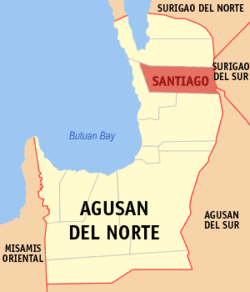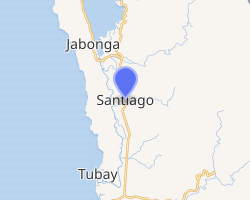Santiago, Agusan del Norte
Santiago, officially the Municipality of Santiago (Cebuano: Lungsod sa Santiago; Tagalog: Bayan ng Santiago), is a 4th class municipality in the province of Agusan del Norte, Philippines. According to the 2015 census, it has a population of 24,200 people.[3]
Santiago | |
|---|---|
| Municipality of Santiago | |
 Santiago River and its dam | |
 Seal | |
 Map of Agusan del Norte with Santiago highlighted | |
OpenStreetMap 
| |
.svg.png) Santiago Location within the Philippines | |
| Coordinates: 9°16′N 125°34′E | |
| Country | |
| Region | Caraga (Region XIII) |
| Province | Agusan del Norte |
| District | 2nd District |
| Founded | January 1, 1937 |
| Chartered | 1969 |
| Barangays | 9 (see Barangays) |
| Government | |
| • Type | Sangguniang Bayan |
| • Mayor | Franklin D. Lim |
| • Vice Mayor | Zenaida C. Lim |
| • Congressman | Ma. Angelica Rosedell A. Matba |
| • Electorate | 13,709 voters (2019) |
| Area | |
| • Total | 275.61 km2 (106.41 sq mi) |
| Population (2015 census)[3] | |
| • Total | 24,200 |
| • Density | 88/km2 (230/sq mi) |
| • Households | 4,491 |
| Economy | |
| • Income class | 4th municipal income class |
| • Poverty incidence | 39.52% (2015)[4] |
| • Revenue (₱) | 88,423,916.45 (2016) |
| Time zone | UTC+8 (PST) |
| ZIP code | 8608 |
| PSGC | |
| IDD : area code | +63 (0)85 |
| Climate type | tropical rainforest climate |
| Native languages | Agusan language Butuanon Cebuano Higaonon Tagalog |
| Website | www |
Geography
According to the Philippine Statistics Authority, the municipality has a land area of 275.61 square kilometres (106.41 sq mi) [2] constituting 10.09% of the 2,730.24-square-kilometre- (1,054.15 sq mi) total area of Agusan del Norte.
Barangays
Santiago is politically subdivided into 8 barangays.[5]
| PSGC | Barangay | Population | ±% p.a. | |||
|---|---|---|---|---|---|---|
| 2015[3] | 2010[6] | |||||
| 160210002 | Curva | 8.9% | 2,155 | 2,041 | 1.04% | |
| 160210010 | Estanislao Morgado | 7.5% | 1,817 | 1,347 | 5.86% | |
| 160210003 | Jagupit | 10.5% | 2,538 | 2,254 | 2.29% | |
| 160210005 | La Paz | 6.7% | 1,630 | 1,520 | 1.34% | |
| 160210007 | Poblacion I | 22.4% | 5,418 | 5,442 | −0.08% | |
| 160210011 | Poblacion II | 17.4% | 4,214 | 3,931 | 1.33% | |
| 160210008 | San Isidro | 10.1% | 2,450 | 2,334 | 0.93% | |
| 160210009 | Tagbuyacan | 9.1% | 2,202 | 2,086 | 1.04% | |
| Total | 24,200 | 20,955 | 2.78% | |||
Climate
| Climate data for Santiago, Agusan del Norte | |||||||||||||
|---|---|---|---|---|---|---|---|---|---|---|---|---|---|
| Month | Jan | Feb | Mar | Apr | May | Jun | Jul | Aug | Sep | Oct | Nov | Dec | Year |
| Average high °C (°F) | 27 (81) |
27 (81) |
28 (82) |
29 (84) |
30 (86) |
29 (84) |
29 (84) |
29 (84) |
29 (84) |
29 (84) |
28 (82) |
28 (82) |
29 (83) |
| Average low °C (°F) | 23 (73) |
22 (72) |
22 (72) |
23 (73) |
24 (75) |
25 (77) |
24 (75) |
24 (75) |
24 (75) |
24 (75) |
24 (75) |
23 (73) |
24 (74) |
| Average precipitation mm (inches) | 210 (8.3) |
161 (6.3) |
123 (4.8) |
85 (3.3) |
148 (5.8) |
186 (7.3) |
164 (6.5) |
157 (6.2) |
141 (5.6) |
190 (7.5) |
223 (8.8) |
200 (7.9) |
1,988 (78.3) |
| Average rainy days | 21.0 | 16.8 | 18.5 | 18.2 | 24.9 | 27.7 | 28.4 | 27.0 | 26.1 | 27.6 | 24.6 | 22.0 | 282.8 |
| Source: Meteoblue [7] | |||||||||||||
History
In the later part of 1898, a group of natives fleeing from the municipality of Jabonga settled in a place recognized by the municipality of Cabadbaran as barrio Santiago, However, in 1924 the Aciga River swelled its banks, destroying all properties, crops and animals along it. This forced the inhabitants of Santiago, Cabadbaran to transfer to barrio Jagupit. In 1936, the same river wrought extensive damage which made the inhabitants decide to transfer at the foot of the hill, particularly at Sitio Paypay, which was inhabited by two groups of natives-the Manobo and the Mamanwa.
The construction of the national highway, which passes thru sitio Paypay, lured more people to settle in the place.
On April 26, 1959, the name Paypay was changed to Santiago through Republic Act 2170,[8] in honor of Senior Santiago or Saint James.
In 1964, the barrio officials of Santiago indicated their desire to become a separate municipality. Finally, on June 15, 1969, the barrios of Santiago and Jagupit were separated from Cabadbaran and constituted into the new municipality of Santiago, through Republic Act 5242.[9]
Demographics
|
| |||||||||||||||||||||||||||||||||
| Source: Philippine Statistics Authority[3][6][10][11] | ||||||||||||||||||||||||||||||||||
In the 2015 census, Santiago had a population of 24,200.[3] The population density was 88 inhabitants per square kilometre (230/sq mi).
Government
In 1972, the first elected Mayor was Nenita Morgado. She served her terms of office until 1986.
On April 1, 1986, Secretary Aquilino Pimentel designated Franklin D. Lim as the OIC, Municipal Mayor of the Municipality of Santiago. He served his terms of office until 1998.
From 1998 to 2007 ( 3 terms), Zenaida C. Lim served as the elected Mayor of Santiago.
From 2007 to 2013 (2 terms), Franklin D. Lim became the elected Mayor of Santiago. He was elected President of the League of Municipalities of the Philippines (LMP)- Agusan del Norte Chapter, and subsequently became the LMP National Auditor during his term.
From 2013 to 2016 (1 term), Zenaida C. Lim became the Mayor of Santiago. Various improvements were experienced by the constituents particularly on improving rural accessibility, reducing rural poverty, and increasing household incomes.
Also in 2015, the Municipality of Santiago passed four areas of Seal of Good Local Governance (SGLG) under the DILG, namely: Financial Housekeeping, Business-Friendliness, Peace and Order, and Environmental Protection.
On June 30, 2016, Franklin D. Lim served his term of office as the elected Mayor of Santiago.
On November 29, 2017, the LGU received an Award being an SGLG Awardee under the DILG at Manila Hotel, Manila, and became a recipient-LGU for the Performance Challenge Fund (PCF). [(Note: Award received by MLGOO Karolus Joseph A. Fuertes, Treasurer Lorraine M. Nasayao, MDRRMO Ramonito P. Maestrado, Accountant OIC Jocelyn L. Cabucos)]
The LGU passed seven (7) core areas of SGLG, namely: Good Financial Housekeeping, Business-Friendliness and Competitiveness, Disaster Preparedness, Social Protection, Peace and Order, Environmental Management, and Tourism, Culture and the Arts.
On June 30, 2019, Franklin D. Lim also served his term of Office (2nd term) as the elected Mayor of Santiago. He was elected President of the LMP Agusan del Norte Chapter in July 2019, and subsequently became the LMP National Treasurer during the LMP Executive Committee and National Directorate Elections.
References
- "Municipality". Quezon City, Philippines: Department of the Interior and Local Government. Retrieved 31 May 2013.
- "Province: Agusan del Norte". PSGC Interactive. Quezon City, Philippines: Philippine Statistics Authority. Retrieved 12 November 2016.
- Census of Population (2015). "Caraga". Total Population by Province, City, Municipality and Barangay. PSA. Retrieved 20 June 2016.
- "PSA releases the 2015 Municipal and City Level Poverty Estimates". Quezon City, Philippines. Retrieved 12 October 2019.
- "Municipal: Santiago, Agusan del Norte". PSGC Interactive. Quezon City, Philippines: Philippine Statistics Authority. Retrieved 8 January 2016.
- Census of Population and Housing (2010). "Caraga". Total Population by Province, City, Municipality and Barangay. NSO. Retrieved 29 June 2016.
- "Santiago: Average Temperatures and Rainfall". Meteoblue. Retrieved 9 February 2020.
- "Republic Act No. 2170 - An Act Changing the Name of the Barrio of Paypay in the Municipality of Cabadbaran, Province of Agusan, to Santiago". Chan Robles Virtual Law Library. 26 April 1959. Archived from the original on 26 September 2013. Retrieved 17 October 2016.
- "Republic Act No. 5242 - An Act Creating the Municipality of Santiago in the Province of Agusan". Chan Robles Virtual Law Library. 15 June 1968. Archived from the original on 26 September 2013. Retrieved 17 October 2016.
- Censuses of Population (1903–2007). "Caraga". Table 1. Population Enumerated in Various Censuses by Province/Highly Urbanized City: 1903 to 2007. NSO.
- "Province of Agusan del Norte". Municipality Population Data. Local Water Utilities Administration Research Division. Retrieved 17 December 2016.